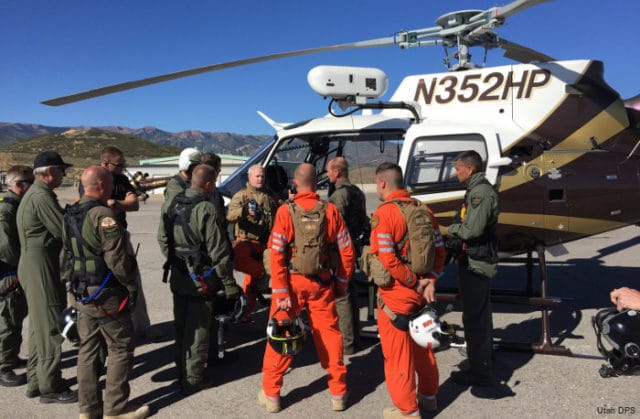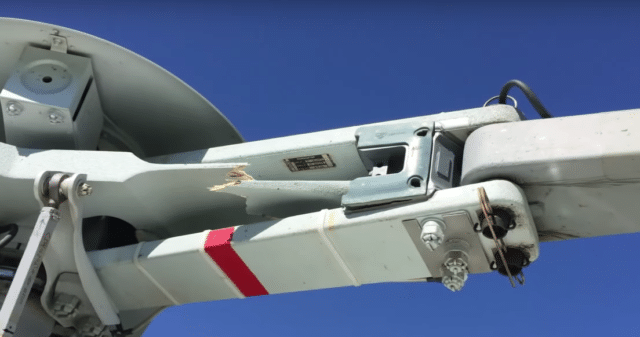High Altitude Rescue Gone Wrong
In 2015, the Utah Department of Public Safety reported that one of its helicopters nearly crashed during a recovery operation in Draper UT.
The NTSB report reference GAA15CA258 and the raw video were released in 2016 but I’ve only just seen this, thanks to the excellent feed of aviation videos run by What You Haven’t Seen.
A hiker had been reported missing in Corner Canyon. Searchers were dropped off by helicopters using one-skid operations (more on this below) and, after a night-search, he was found in the morning near a hiking trail called Jacobs Ladder, in “remote and nearly vertical” terrain. The hiker had fallen and was pronounced dead at the scene. The Utah Department of Public Safety arranged for a ground crew and helicopter to recover the body.

The helicopter was an Airbus (Eurocopter) AS350, registration N253HP with two on board, the pilot and a tactical flight officer. In order to meet the rescuers on a cliff ledge, they attempted a one-skid recovery or “skid load”.
The one-skid manoeuvre is where the helicopter rests one skid on a narrow surface (in this case a rock ledge) while continuing to hover. A one-skid recovery is used when there is not enough space/flat ground in order for the helicopter to touch down properly.
From the Mountain Rescue Association’s manual Helicopters in Search and Rescue Intermediate Level (2008):
In certain situation, pilots and rescuers may choose to perform a hovering or one-skid recovery of a rescue victim.
The factors to be taken into account in selecting a site for a hovering recovery are generally the same as those for selecting a helispot. In these conditions, a smaller ground area, rougher terrain and steeper slope are permissible. On the other hand, it is extremely important that there be plenty of room for both the main rotor and the tail rotor boom, since the pilot may have to turn the helicopter in the event changes in wind direction. An experienced hand signaler, one that the pilot knows is competent, should be at the site and all ground personnel should be within the pilot’s view, if at all possible. In the case of one-skid recoveries on rock outcrops, this may be impractical.
The three-person recovery team used a rescue rope to lower the fallen hiker to a ledge where they could meet the helicopter. The helicopter hovered above them and then descended to bring the right skid onto the outcrop. The team approached the helicopter in order to load the litter.
Clearly, this is a critical phase of flight however you slice it. The narrative of the incident quotes the manual on Situational Awareness by the Mountain Rescue Association:
“Situational Awareness” is “the degree of accuracy by which one’s perception of his/her current environment mirrors reality.” Situational Awareness can also be looked at as a constantly evolving picture of the state of the environment. It is the perception and comprehension of the relevant elements in an incident within a volume of time and space. In this regard, Situational Awareness is not an event, but rather a process that only ends when the search and rescue incident is concluded.
Situational Awareness requires the human operator to quickly detect, integrate and interpret data gathered from the environment. In the case of search and rescue operations, the “human detector” can be anything from the incident commander to a “field grunt.” That is the beauty (and challenge) of Situational Awareness – it requires and demands awareness by all users.
Unfortunately, situational awareness was not a high point of the operation that day. A rescue rope was anchored on the steep terrain above them and one of the ground team was attached to it. As the rescue worker approached the helicopter, the rope was pulled taut and was caught by the main rotor blade, about ten inches from the tip. The cut rope was then pulled back by the main rotor and struck the tail rotor before flying back uphill towards the rescuers who were on the slope above the ledge.
This image apparently shows the initial damage done by the safety rope.

The aircraft rotated abruptly to the left. It began to shake violently and the tail struck the cliff face. The tail flew over the heads of the rescuers and into the cliff wall. The tactical flight officer was thrown out of the open door of the helicopter but caught by his harness and safety line.
The helicopter was described as ‘spinning towards the ground’ but somehow the pilot managed to regain control and flew to lower terrain where he could land upright. As he applied the power to land, the helicopter began shaking violently again until he touched down and reduced the collective pitch. Once safely on the ground, they found that the helicopters main rotor system had been damaged by the rope, with the resulting spin damaging the tail boom and the empennage.
From Accidents in Mountain Rescue Operations by Charley Shimanski for the Mountain Rescue Association:
Damage to the main rotor assembly occurred when the main rotor blade made contact with the taut rope. That caused a fracture to the Starflex Assembly–a critical junction between the rotor blades and main rotor shaft. This is presumably what caused the “violent shaking” that occurred when the rotor blades were under power.
Here’s the video of the helicopter as it comes down; watch the rope at the bottom left of the screen as it snakes across the bottom and down to the team member closest to the helicopter.
What You Haven’t Seen has also put up the raw video without the pauses/slow motion views so that you can see it unedited.
The NTSB report quotes the National Park Service manual Helicopter Rescue Techniques:
Helicopters provide an outstanding rescue tool, but they have specific operating limitations. Recognize that the consequences of a poorly managed helicopter rescue can be swift and fatal. Rescuers need to understand these limits and have the professional discipline not to exceed them during an emergency. As accident investigators repeatedly conclude, “self-imposed psychological pressure” causes us to make poor decisions when adrenaline clouds our judgment. Poor decision-making is preventable yet, tragically, it is a factor in the vast majority of helicopter rescue accidents.
What’s particularly frustrating about this case is that this was not a search and rescue: the hiker had died in the fall. There was no need for the crew to risk their lives for the rescue.
The National Transportation Safety Board determines the probable cause(s) of this accident as follows:
- The ground recovery team member’s failure to secure a rescue rope during the helicopter loading process in steep terrain, resulting in the rope fouling the helicopter’s main rotor system.
A special thank you to a Fear of Landing reader who pointed me at the video posted by What You Haven’t Seen along with the NTSB reference number. Thank you Tammy!








It is easy to be wise after the event. Yes, the crew had been taking a risk that was not really necessary as the victim had already died. All those points taken, but still: these helicopter crews risk their own lives on a regular basis so that others can survive.
This incident, fortunately, had a happy ending, all survived and I suppose so did the helicopter that probably did not have to be written off.
They made a mistake, they no doubt learned a lesson that they will never forget. Nobody is perfect.
I salute these brave people.
Amen. They may have screwed up on the rope, but they “won that one” when the pilot managed to land the chopper despite the damage. I notice nobody else got hurt by the flying rope, either, which probably had something to do with the ground crew’s experience and skill.
I’m thinking it’s time for a policy change. Risking many lives and a very expensive machine to “rescue” a dead body that is in no need of rescue is a foolish misuse of resources.
I guess you have never tried to move a stretcher through rough terrain so you don’t know how much time, manpower and corresponding risk that involves. This highlights the need for a form of long-line or “short haul” recovery system that keeps everybody much safer and coud have been done with a team of two rescuers and one pilot. Society still wants the body recovered.
Mike,
Of course you are right. This was an unnecessary risk as Sylvia’s entry makes abundantly clear.
But still, I want to express my respect and admiration for helicopter crews who time and again are willingly risk their own lives so that others will live.
Though the body was a recovery, not a rescue, the SAR team still needed a ride home.
Was a one-skid operation the right choice? No way to tell with the information we have. But the terrain doesn’t look very horizontal and SAR missions do a lot of one-skid operations.
Hola buenos días es correcto que quieras salvar una vida pero algunas se provocan fallas fatales y perdida de vidas y daños costosos.
Seria un buen tema que comentar en la convención de amigos de la aviación.
The pilot of this operation is one of the most talented and humble guys I’ve met. He will tell you without a doubt that a skid load high angle operation wasn’t really necessary for a recovery. So what. For every recovery they’ve done, they’ve also done a rescue of a live person (or more than 1). It could have just as easily happened on a rescue day rather than recovery, and more people would be calling them heroes instead of arm chair quarterbacking it. There are certainly things to learn from the event, but the tone of some commentary on this situation irks me. SAR members choose to risk their lives in the moment for the good of others. Everyone else gets to analyze from the comfort of their desk afterward. Please be mindful of that.